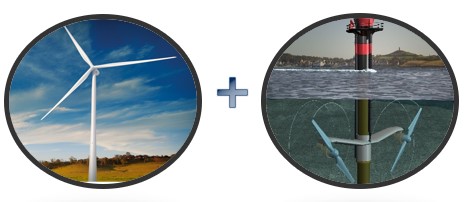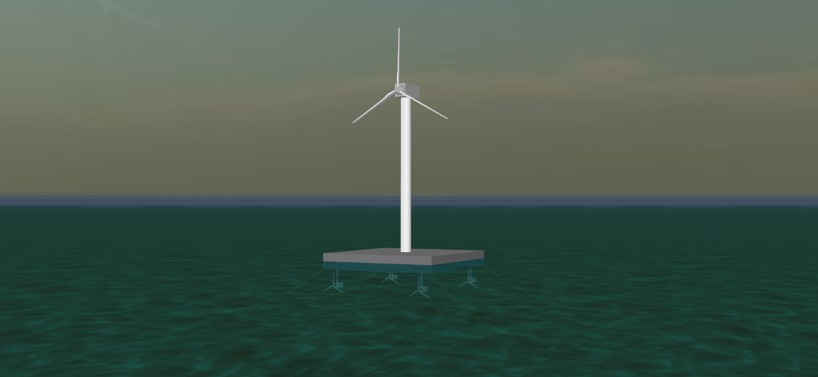Concept explanation
The concept of this project is to integrate wind and current energy resources in a floating structure, capable to be used for river applications. This novel idea is already being studied in the literature [1] for some time, combining various offshore renewable energy devices to produce effective synergy in either floating or fixed structures mainly for large scale applications [2],[3]. However, the scope of this project was to focus on a small-scale application in order to cope with the technical limitations, as well as the technological constraints, that could refrain the system from being expanded in large scale implementation.
Why floating?
We chose to make the system floating because, contrary to a fixed construction, a floating structure offers a good solution to accommodate multiple current turbines. At the same time, theoretically it does not present the instability disadvantage, since the waves in a river are small in height and long in period and thus, they do not induce significant motions to the platform. Additionally, a fixed structure would create problems in fish movements and migration routes and that, in tandem with the fact that in many rivers the existence of a stationary model is legally prohibited, was a complementary reason in favor of this decision.
Why floating?
We chose to make the system floating because, contrary to a fixed construction, a floating structure offers a good solution to accommodate multiple current turbines. At the same time, theoretically it does not present the instability disadvantage, since the waves in a river are small in height and long in period and thus, they do not induce significant motions to the platform. Additionally, a fixed structure would create problems in fish movements and migration routes and that, in tandem with the fact that in many rivers the existence of a stationary model is legally prohibited, was a complementary reason in favor of this decision.
Advantages
|
Disadvantages
|
Design
The design which we came up with for our hybrid system comprises 1 wind turbine and 4 river current turbines mounted on top of and beneath a barge floating platform respectively, which in turn is tethered to the riverbed with mooring lines. Below an illustration of the complete design made in Orcaflex is presented:
Figure 1: Complete design of Hapi in Orcaflex
References
[1] Li, L., Gao, Y., Yuan, Z., Day, S. and Hu, Z. (2018). Dynamic response and power production of a floating integrated wind, wave and tidal energy system. Renewable Energy, 116, pp.412-422.
[2] Lande-Sudall, D., Stallard, T. and Stansby, P. (2018). Co-located offshore wind and tidal stream turbines: Assessment of energy yield and loading. Renewable Energy, 118, pp.627-643.
[3] Singh, P., Chen, Z. and Choi, Y. (2016). Numerical analysis for a proposed hybrid system with single HAWT, double HATCT and vertical oscillating wave energy converters on a single tower. Journal of Mechanical Science and Technology, 30(10), pp.4609-4619.
[2] Lande-Sudall, D., Stallard, T. and Stansby, P. (2018). Co-located offshore wind and tidal stream turbines: Assessment of energy yield and loading. Renewable Energy, 118, pp.627-643.
[3] Singh, P., Chen, Z. and Choi, Y. (2016). Numerical analysis for a proposed hybrid system with single HAWT, double HATCT and vertical oscillating wave energy converters on a single tower. Journal of Mechanical Science and Technology, 30(10), pp.4609-4619.
|
STRATHCLYDE UNIVERITY
16 Richmond Street Glasgow G1 1XQ Scotland, United Kingdom Phone: +44 141 552 4400 https://www.strath.ac.uk © Copyright 2018 |



